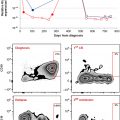Burkitt Lymphoma
National Cancer Institute, National Institutes of Health, Bethesda, MD, USA
1. What are the diagnostic considerations in clinically suspected highly aggressive non-Hodgkin’s lymphoma (NHL), as in this case?
In cases such as this, a highly aggressive NHL such as Burkitt lymphoma (BL) should be considered, and medical oncology consultation prior to biopsy is appropriate. Subclassification of NHLs relies on clinical, morphologic, and cytogenetic and molecular features, rendering the initial biopsy critical. In general, a fine-needle aspirate is insufficient. In the present case, BL should be suspected due to the location of the mass and the rapid onset of symptoms. BL is the fastest growing human tumor and can double in size in 24–48 h. It has a male predilection and usually occurs in children but is also seen in adults. BL presents in the abdomen in most cases and often will involve the cecum, mimicking appendicitis. Surgical resection of the tumor in BL has been associated with favorable outcomes, but it carries the potential for morbidity and can delay definitive therapy. In most cases, surgery is unnecessary with prompt institution of immunochemotherapy. Incisional biopsy via laparoscopy or adequate CT-guided core needle biopsies with tissue sent for fluorescent in situ hybridization (FISH) testing for rearrangements of the MYC oncogene is mandatory. Goal turnaround time from first suspecting BL to initiation of therapy is 48–72 hours, making a high initial index of suspicion critical. Morphologically, BL typically demonstrates a “starry sky” appearance of diffuse and monotonous small to medium-sized B-cells with a distinct immunophenotypic profile that is positive for surface IgM, CD20, CD10, and B-cell lymphoma-6 (BCL6), and negative for BCL2, which distinguishes it from diffuse large B-cell lymphoma (DLBCL). Still, unclassifiable cases with intermediate features exist, and hematopathologists may have difficulty distinguishing BL from DLBCL on morphologic grounds alone, further supporting the need for FISH testing.
2. What is the current understanding about the pathogenesis of BL and its relationship to DLBCL?
The normal germinal center B-cell is the suspected cell of origin for both BL and DLBCL, and these malignancies share overlapping clinical and pathologic features. While essentially all cases of BL have demonstrable MYC rearrangements, it is typically in the background of a few other aberrations (“MYC simple”). In contrast, up to 10% of newly diagnosed DLBCL cases will also harbor MYC rearrangements, but these cases are usually associated with multiple other chromosomal abnormalities (“MYC complex”). Molecular classification studies readily distinguish between the two entities, demonstrating a unique gene expression profile for BL and suggesting that different oncogenic pathways are activated. MYC is pathognomonic of BL, but until recently, the cooperative pathways in BL were unknown. RNA-resequencing (RNA-seq) analysis on 28 biopsies of sporadic BL confirmed the molecular distinction of BL and identified many genes that were more frequently mutated in BL than DLBCL, including TCF3, ID3, and TP53. Another group recently reported that ID3 mutations were seen in up to 38% of BL cases and not seen in cases of DLBCL. Components of the B-cell receptor (BCR) are upregulated by TCF3, similar to that seen in DLBCL but via a different mechanism. In the activated B-cell (ABC) subtype of DLBCL, BCR signaling requires the nuclear factor kappa B (NF-κB) pathway and is the “chronic active” form. In BL, however, the BCR signaling is independent of the NF-κB pathway and is more akin to “tonic” BCR signaling that engages phosphatidylinositide-3 (PI3) kinase (PI3K) signaling. RNA interference screens recently demonstrated that knockdown of the BCR subunit CD79A and inhibition of PI3K were toxic to BL cell lines, further supporting these as cooperative pathways in BL pathogenesis. In support of this hypothesis, Sander et al. (2012) demonstrated that combining constitutive c-MYC expression and PI3K activity in germinal center B-cells of the mouse led to tumors with a striking similarity to BL.
3. How do cofactors such as Epstein–Barr virus (EBV), malaria, and human immunodeficiency virus (HIV) contribute to the pathogenesis of BL?
The syndrome of rapidly enlarging tumors of the jaw in children was first described by the Irish surgeon Denis Burkitt while working in Uganda in 1958. Today, we subdivide BL into three clinical variants—endemic (African) BL, sporadic BL, and immunodeficiency (HIV)-associated B—with important differences in epidemiology, clinical presentation, and biology. Endemic BL, which is the most common subtype, occurs in developing countries such as equatorial Africa and Papua New Guinea. It frequently affects the jaw and is seen almost exclusively in children. Endemic BL is an apparent polymicrobial disease, with clonal EBV found in the neoplastic cells of virtually all patients; cases are also linked to the prevalence of malaria, and the incidence is highest in people with high titers of Plasmodium falciparum. In contrast, EBV occurs in 20–40% of sporadic BL and HIV-associated cases. Evidence for the oncogenic role of EBV stems from the fact that cell lines that have lost EBV do not induce tumors in mice, but re-infection with EBV reestablishes a malignant phenotype. EBV contributes to genomic instability in endemic BL. The relationship of HIV and BL was first noted in 1982; it may also increase the risk of BL, possibly via chronic stimulation of B-cells, as is suspected in malaria. Interestingly, HIV-associated BL can occur at any CD4 count, suggesting that immunosuppression itself is not the sole contributing factor. Gene expression profiles of the different subtypes reveal that cases of BL cluster separately from other lymphomas, confirming them as distinct entities but with some slight differences among the subtypes, with the endemic and immunodeficiency subtypes being almost identical.
4. What is the most effective chemotherapy regimen in BL?







